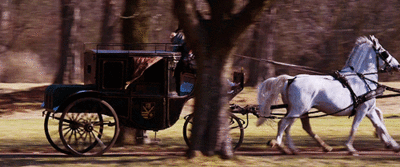Chi pensa ad una storia di Agatha Christie solitamente immagina un'antica residenza, situata nel verde della campagna inglese, con un maggiordomo, magari di proprietà di un ricco anziano 'gentleman', che convive con nipoti animati da sentimenti di avarizia o d'invidia, ed una tazza di tè, posata su di un tavolino accanto ad un poltrona in un luminoso salone situato al piano terra, che contiene un invisibile pizzico di arsenico, divenuto per eccellenza sinonimo di veleno ...
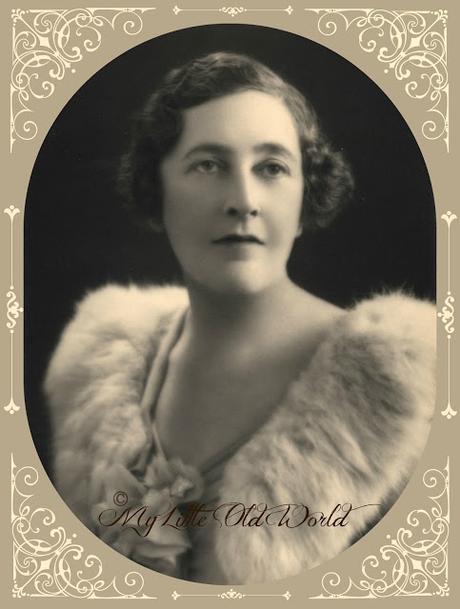
Dame Agatha Mary Clarissa Miller, Lady Mallowan, nota come Agatha Christie (Torquay, 15 settembre 1890 – Wallingford, 12 gennaio 1976), fu una celeberrima scrittrice britannica, resa famosa innanzitutto dagli innumerevoli racconti e romanzi gialli - tanto da meritare l'appellativo di 'Signora Omicidi' -, ma che scrisse anche alcuni romanzi rosa con lo pseudonimo di Mary Westmacott.
Ella vantava una profonda conoscenza in fatto di veleni, aveva quella che potremmo definire una vera e propria cultura in quanto a piante da cui venivano estratte e degli effetti che esse inducevano, tanto da rendere i suoi romanzi così verosimilmente affascinanti, conoscenza che ella aveva maturato durante gli anni della Grande Guerra, che la videro prestare servizio presso l'ospedale di Torquay.
Gli 'avvelenatori' della Christie hanno spesso accesso agli armadietti dei medicinali in casa, oppure si recano direttamente nel giardino o nei prati intorno l'abitazione, perché molti veleni sono ottenuti da piante ornamentali facilmente reperibili, alcune persino selvatiche ... non vi parlerò perciò dell'arsenico che, anche se largamente utilizzato nel secolo scorso in insetticidi ed erbicidi non è ricavato da piante, bensì dal suolo e dal sottosuolo, ma andiamo a vedere insieme quali sono quelli più comuni, ovvero quelli più facilmente reperibili in natura, di cui gli assassini dei suoi racconti e dei suoi romanzi hanno fatto uso:
- RICINO - RICINUS COMMUNIS -
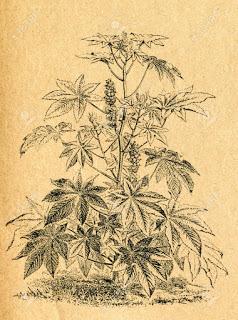
Stampa botanica di artista sconoscito, pubblicata da W.L.Anczyc, 1911
E' la fonte dell'olio di ricino e viene coltivata commercialmente, tuttavia, per il suo fogliame così attraente, lo si trova spesso quale arbusto ornamentale nei giardini. Oltre all'olio, i semi di Ricinus communis contengono ricina, una proteina che può uccidere un adulto anche se assunta in piccole quantità.
La vittima più famosa di ricina fu Georgi Markov, che, nel 1978, sul ponte Waterloo di Londra ricevette un pallottola sparata nella parte posteriore della coscia la quale rilasciava ricina nel suo flusso sanguigno. Morì quattro giorni dopo perché tale proteina bloccò la normale crescita ed il processo di riparazione nelle sue cellule.
Agatha Christie utilizzò la ricina quasi cinquanta anni prima, nel racconto The House of Lurking Death - La morte è di casa della serie Tommy e Tuppence: in due s'indaga meglio quando tre membri della stessa famiglia caddero vittime di panini che ne erano farciti. La sua descrizione di avvelenamento da ricina è un raro esempio di inesattezza nella scienza della Christie - le sue vittime muoiono troppo in fretta.
Anche se l'ingestione di ricina è considerevolmente meno rischiosa di un iniezione diretta nel corpo, mangiare i semi di Ricinus communis non è davvero raccomandato, una manciata di semi, ben masticati, può realmente essere fatale.
- DIGITALE - DIGITALIS PURPUREA -
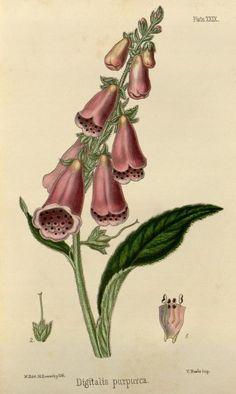
Stampa botanica di Edward Hamilton, 1852
Gli usi medicinali della digitale sono ampiamente noti e la pianta è stato utilizzata in preparazioni medicinali per centinaia di anni. I composti a base di digitale agiscono sul funzionamento del muscolo cardiaco, rallentando e intensificando le contrazioni del cuore, per cui, assunti in dosi adeguate, tali composti costituiscono un trattamento efficace per ottenere ritmi cardiaci rapidi e coordinati; se assunti però in quantità eccessiva rallentano i battiti cardiaci fino a fermare definitivamente il cuore, determinando una rapida morte.
La Christie ha utilizzato sia la pianta sia isolati farmaci digitalici per uccidere le 'sue vittime'.
Poiché le digitali producono fiori nel secondo anno di crescita, l'avvelenatore di Postern of Fate - Le porte di Damasco e quello di The Herb of Death - L'erba della morte ne raccolgono per caso le foglie insieme a quelle della salvia essendo state le due piante poste accanto l'una all'altra ed avendo esse entrambe foglie lanceolate e morbide e perciò, in modo del tutto fortuito, queste vennero aggiunte al pasto serale ed indussero l'effetto letale che ben conosciamo.
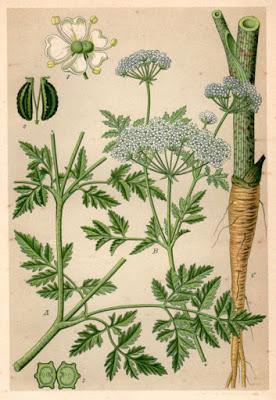
Quella che comunemente conosciamo come cicuta contiene numerosi alcaloidi tra cui una tossina, la coniina, che colpisce il sistema nervoso: pensate che si ritiene che la dose mortale per un essere umano sia di qualche grammo di frutti verdi. Nell'uomo l'ingestione della cicuta provoca problemi digestivi, cefalee ed in seguito parestesia, diminuzione della forza muscolare, e infine una paralisi ascendente.
Il potere tossico di questa tossina è talmente elevato da essere in grado di agire anche indirettamente, induce cioè avvelenamento anche in seguito ad ingestione di un animale che se ne era cibato in precedenza.
Alla stessa famiglia di piante appartengono anche specie commestibili come il prezzemolo selvatico, il cerfoglio e le comuni carote.
Agatha Christie utilizzò questo famigerato veleno nel suo romanzo Five little Pigs - Il ritratto di Elsa Greer in cui Amyas Crale venne assassinato per tramite di un estratto di cicuta, a base, appunto di coniina, aggiunto alla sua birra: i lenti effetti paralizzanti del composto lo fecero vacillare e crollare di fronte al suo cavalletto, ancora cosciente egli era incapace di gridare o di palesare la sua angoscia per spegnersi infine quando la coniina paralizzò i suoi muscoli respiratori.
- BELLADONNA - ATROPA BELLADONNA -
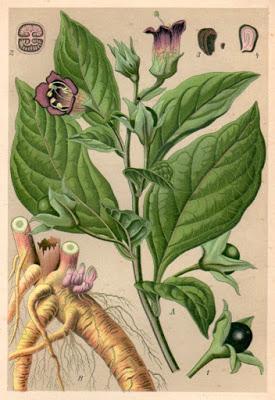
Stampa botanica di artista sconosciuto, 1901
Atropa belladonna, o semplicemente belladonna, è una delle molteplici piante contenenti il composto letale dal nome atropina; esso colpisce i nervi, aumentando la frequenza cardiaca, riducendo la sudorazione e, notoriamente, fa sì che le pupille degli occhi si dilatino, motivo per cui il loro succo veniva utilizzato nel medioevo dalle nobildonne per avere occhi più grandi e più belli ( a quel tempo le pupille 'grandi' erano sinonimo di leggiadria ).
Ancor oggi l'atropina è ampiamente utilizzata, in dosi appropriate, come componente di colliri che, proprio per questa sua funzione dilatatoria, consentano un migliore esame dell'interno dell'occhio.
Gli avvelenatori della Christie ( The Cretan Bull - Il Toro cretese, The Caribbean Mystery - Il mistero dei Caraibi, The Thumb Mark of St. Peter - Il Marchio del pollice di San Pietro ) usavano l'atropina in quantità piuttosto elevate per indurre terribili allucinazioni nelle loro vittime, con l'intento di indurle alla follia ed infine al suicidio.
- ACONITO - ACONITUM VARIEGATUM -
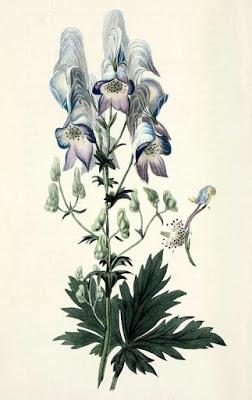
La componente tossica contenuta nella pianta dell'Aconitum è l'aconitina, una potente neurotossina letale in piccole quantità nella sua forma pura, ovvero così come la troviamo in natura: i sintomi compaiono circa quindici minuti dopo l'ingestione, cominciando con una crescente sensazione di bruciore nella bocca e nella gola e la vittima muore dopo un massimo di quattro ore di agonia in preda a convulsioni.
Se è vero che l'aconitina può essere ingerita ( 4.50 from Padding - Istantanea di un delitto, They Do It With Mirrors - Giochi di prestigio ) o iniettata, è altresì vero che i suoi effetti tossici compaiono anche quando essa viene assorbita per tramite dell'epidermide, per cui bisogna prestare particolare attenzione quando si maneggia la pianta e vestire un paio di guanti, poiché di tutte quelle che abbiamo preso in esame oggi risulta essere la più pericolosa, visto che è da temere il solo contatto con essa !
Anche oggi il nostro tempo è giunto al termine, carissimi amici ed amati lettori, e nella speranza che abbiate trovato interessante anche questo argomento, del tutto insolito, ma piuttosto curioso, vi lascio non senza avervi prima augurato ogni bene per il tempo che ci separa dal nostro prossimo incontro,
a presto ♥



Who thinks of a story by Agatha Christie usually imagines an old mansion, located in the beautiful English countryside, with a butler, perhaps owned by a wealthy old 'gentleman', living with nephews with feeling greed or envy, and a cup of tea, placed on a table next to an armchair in a bright living room on the ground floor, which contains an invisible pinch of arsenic, which has become with excellence synonymous for poison ...
- picture 1
Dame Agatha Mary Clarissa Miller, Lady Mallowan, better known as Agatha Christie ( Torquay, September 15th, 1890 - Wallingford, January 12th, 1976 ), was a famous British writer, first became famous by the innumerable thriller stories and novels - enough to merit the label 'Lady Murders' - but who also wrote some romance novels under the pseudonym of Mary Westmacott.
The 'poisoners' of Agatha Christie have often access to the medicine cabinets at home, or go directly into the garden or in the meadows around the house, because many poisons are obtained from ornamental plants readily available, some grown even wild ... So I won't tell you about arsenic, which, although widely used during the last century in insecticides and herbicides, is not obtained from plants, but from the soiland the subsoil, but we're going to see together the most common of them, I mean those most easy to find in nature, including those the murderers of her stories and novels have used most:
- CASTOR - RICINUM COMMUNIS -
- picture 2 - Botanical print by unknown artist, published by W.L.Anczyc, 1911
It is the source of castor oil and is grown commercially. However, its foliage so attractive means it is also often cultivated as an ornamental shrub in gardens. Besides the oil, the seeds of Ricinus communis contain ricin, a protein that can kill an adult even when taken in small amounts.
The most famous victim of ricin was Georgi Markov, who, in 1978, on the Waterloo bridge in London received a bullet shot in the back of the thigh releasing ricin in his bloodstream. He died four days later because the protein blocked the normal growth and repair process in his cells; Agatha Christie used ricin almost fifty years earlier, in the tale The House of Lurking Death from the Tommy and Tuppence series where three members of the same family were victims of sandwiches that were stuffed with it. Her description of ricin poisoning is a rare example of inaccuracy in her science, for her victims die too quickly.
Although the ingestion of ricin is considerably less of a risk than a direct injection into the body, to eat the seeds of Ricinus communis is not really recommended, a handful of seeds, chewed well, can actually be fatal !
- FOXGLOVE - DIGITALIS PURPUREA -
- picture 3 - Botanical print by Edward Hamilton, 1852
The medical uses of digital are widely known and the plant has been used in medicinal preparations for hundreds of years. The compounds based on digital act on the functioning of the heart muscle, slowing and intensifying the contractions of the heart, that's the reason why, taken in appropriate doses, the compounds based digital constitute an effective treatment for obtaining rapid and coordinated heart rhythms, but if taken in excessive amounts it slows heartbeats to permanently stop the heart, causing a rapid death.
Christie has used both the plant and digitalis drugs to kill her victims.
Since the digital produce flowers in the second year of growth, the poisoner of Postern of Fate and that of The Herb of Death accidentally picks up its leaves together with those of the sage, having been the two plants placed next to each other and having them both lance-shaped and soft leaves; collected for mistake, they were added to the evening meal by accident and led to the lethal effect that we well know.
- HEMLOCK - CONIUM MACULATUM -
- picture 4 - Botanical print by Wilhelm Heinrich Prestele, 1901
What is commonly know as hemlock contains many alkaloids including a toxin, the coniine, which affects the nervous system: it's believed that the lethal dose for a human being is a few grams of green fruits. In humans, the ingestion of hemlock causes digestive problems, headaches and later paresthesia, decreased of the muscle strength, and finally an ascending paralysis.
The toxic power of this toxin is so high as to be able to act also indirectly, i.e. induces poisoning even after the ingestion of an animal that has eaten it previously.
At the same family of plants belong also edible species such as wild parsley, chervil and the common carrot.
Agatha Christie used this notorious poison in her novel Five Little Pigs where Amyas Crale was assassinated by means of an extract of hemlock, with a basis of coniine, added to his beer: the slow crippling effects of the compound did him falter and collapse in front of his easel; still conscious, he was unable to cry or express his anguish to expire, finally, when the coniine paralyzed his respiratory muscles.
- DEADLY NIGHTSHADE - ATROPA BELLADONNA -
- picture 5 - Botanical print by unknown artist, 1901
Atropa belladonna, or more simply deadly nightshade, is one of the many plants containing thelethal compound named atropine: it affects the nerves, increasing the heart rate, reducing perspiration and, notoriously, causing dilation of the pupils of the eyes , which is why their juice was used in the Middle Ages by noblewomen to have eyes bigger and more beautiful ( at that time 'large' pupils were synonymous with grace ).
Atropine is still widely used, in appropriate doses, as part of eye drops which, because of this dilator function, allows a better examination of the interior areas of the eye.
Christie's poisoners ( The Cretan Bull, The Caribbean Mystery, The Thumb Mark of St. Peter ) used atropine in rather high quantities to cause terrible hallucinations in their victims, with the intention of inducing them to madness, and finally to the suicide.
- MONKSHOOD - ACONITUM NAPELLUS -
- picture 6 - Botanical print by William S.Clark, 1820 - 1829
The toxic component contained in the plants of monkshood is aconitine, a powerful neurotoxin, lethal in small quantities in its pure form, that is as we find it in nature: the symptoms appear about fifteen minutes after ingestion, beginning with a growing sense of burning in mouth and throat and the victim dies after a maximum of four hours of agony in convulsions.
If it's true that the aconitine can be ingested ( 4:50 from Padding, They Do It With Mirrors ) or injected, it is also true that its toxic effects appear even when it is absorbed by means of the skin, so we have to be very careful when handling the plant and to wear a pair of gloves, because amongst all those the plants we have examined today it is the most dangerous, as it is to fear just the contact with it!
Even today, our time has come to a close, dear friends and beloved readers of mine, and in the hope that you've found this topic interesting, for it's very unusual, but quite peculiar, I take my leave of you, wishing you all the best for the time that separates us from the next time we're meeting,
see you soon ♥
